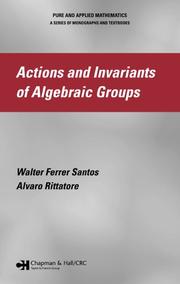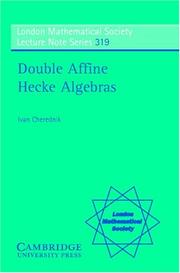| Listing 1 - 9 of 9 |
Sort by
|

ISBN: 082475896X 9780824758967 Year: 2005 Publisher: Boca Raton, Fla Chapman & Hall
Abstract | Keywords | Export | Availability | Bookmark
 Loading...
Loading...Choose an application
- Reference Manager
- EndNote
- RefWorks (Direct export to RefWorks)
Algebraic geometry --- 512.54 --- Groups. Group theory --- 512.54 Groups. Group theory --- Affine algebraic groups --- Invariants --- Algebraic groups, Affine --- Group schemes (Mathematics)
Book
ISBN: 9781107608603 9781139226660 1139226665 9781139780094 1139780093 1107608600 1139889869 113977705X 1139783920 1139794450 1139783084 1299405754 1139778579 9781139889865 9781139783927 9781139794459 9781139783088 9781299405752 9781139778572 Year: 2012 Volume: 401 Publisher: Cambridge New York Cambridge University Press
Abstract | Keywords | Export | Availability | Bookmark
 Loading...
Loading...Choose an application
- Reference Manager
- EndNote
- RefWorks (Direct export to RefWorks)
The theory of Schur-Weyl duality has had a profound influence over many areas of algebra and combinatorics. This text is original in two respects: it discusses affine q-Schur algebras and presents an algebraic, as opposed to geometric, approach to affine quantum Schur-Weyl theory. To begin, various algebraic structures are discussed, including double Ringel-Hall algebras of cyclic quivers and their quantum loop algebra interpretation. The rest of the book investigates the affine quantum Schur-Weyl duality on three levels. This includes the affine quantum Schur-Weyl reciprocity, the bridging role of affine q-Schur algebras between representations of the quantum loop algebras and those of the corresponding affine Hecke algebras, presentation of affine quantum Schur algebras and the realisation conjecture for the double Ringel-Hall algebra with a proof of the classical case. This text is ideal for researchers in algebra and graduate students who want to master Ringel-Hall algebras and Schur-Weyl duality.
Schur functions. --- Weyl groups. --- Representations of Lie groups. --- Affine algebraic groups. --- Algebraic groups, Affine --- Group schemes (Mathematics) --- Lie groups --- Weyl's groups --- Group theory --- S-functions --- Schur's functions --- Holomorphic functions
Book
ISBN: 9783030638498 9783030638504 9783030638511 9783030638481 Year: 2021 Publisher: Cham Springer International Publishing :Imprint: Birkhäuser
Abstract | Keywords | Export | Availability | Bookmark
 Loading...
Loading...Choose an application
- Reference Manager
- EndNote
- RefWorks (Direct export to RefWorks)
Group theory --- Category theory. Homological algebra --- Ordered algebraic structures --- Algebra --- Mathematical physics --- algebra --- wiskunde --- fysica --- Algebra, Homological. --- Affine algebraic groups. --- Algebraic groups, Affine --- Group schemes (Mathematics) --- Homological algebra --- Algebra, Abstract --- Homology theory
Book
ISBN: 0816239541 Year: 1971 Publisher: San Francisco (Calif.): Holden-Day
Abstract | Keywords | Export | Availability | Bookmark
 Loading...
Loading...Choose an application
- Reference Manager
- EndNote
- RefWorks (Direct export to RefWorks)
512.74 --- Hopf algebras --- Lie groups --- Representations of groups --- Affine algebraic groups --- #WWIS:d.d. Prof. L. Bouckaert/ALTO --- Algebraic groups, Affine --- Group schemes (Mathematics) --- Group representation (Mathematics) --- Groups, Representation theory of --- Group theory --- Groups, Lie --- Lie algebras --- Symmetric spaces --- Topological groups --- Algebras, Hopf --- Algebraic topology --- Algebraic groups. Abelian varieties --- 512.74 Algebraic groups. Abelian varieties --- Geometrie algebrique - groupes algebriques
Book
ISBN: 9781470424091 1470424096 Year: 2017 Publisher: Providence American Mathematical Society
Abstract | Keywords | Export | Availability | Bookmark
 Loading...
Loading...Choose an application
- Reference Manager
- EndNote
- RefWorks (Direct export to RefWorks)
Affine algebraic groups --- Representations of groups. --- Groupes algébriques affines --- Représentations de groupes --- Affine algebraic groups. --- Group representation (Mathematics) --- Groups, Representation theory of --- Group theory --- Algebraic groups, Affine --- Group schemes (Mathematics) --- Groupes algébriques affines. --- Représentations de groupes. --- Groupes algébriques affines --- Représentations de groupes --- Representations of groups

ISBN: 9780511546501 9780521609180 0511113188 9780511113185 0511111657 9780511111655 051111267X 9780511112676 0511546505 0521609186 1280414960 9781280414961 0521609186 1107127661 9786610414963 0511171048 0511196679 051129820X Year: 2005 Volume: 319 Publisher: Cambridge, U.K. New York Cambridge University Press
Abstract | Keywords | Export | Availability | Bookmark
 Loading...
Loading...Choose an application
- Reference Manager
- EndNote
- RefWorks (Direct export to RefWorks)
This is an essentially self-contained monograph in an intriguing field of fundamental importance for Representation Theory, Harmonic Analysis, Mathematical Physics, and Combinatorics. It is a major source of general information about the double affine Hecke algebra, also called Cherednik's algebra, and its impressive applications. Chapter 1 is devoted to the Knizhnik-Zamolodchikov equations attached to root systems and their relations to affine Hecke algebras, Kac-Moody algebras, and Fourier analysis. Chapter 2 contains a systematic exposition of the representation theory of the one-dimensional DAHA. It is the simplest case but far from trivial with deep connections in the theory of special functions. Chapter 3 is about DAHA in full generality, including applications to Macdonald polynomials, Fourier transforms, Gauss-Selberg integrals, Verlinde algebras, and Gaussian sums. This book is designed for mathematicians and physicists, experts and students, for those who want to master the double Hecke algebra technique. Visit http://arxiv.org/math.QA/0404307 to read Chapter 0 and selected topics from other chapters.
Hecke algebras. --- Affine algebraic groups. --- Harmonic analysis. --- Knizhnik-Zamolodchikov equations. --- Orthogonal polynomials. --- Fourier analysis --- Functions, Orthogonal --- Polynomials --- KZ equations --- Zamolodchikov equations, Knizhnik --- -Mathematical physics --- Quantum field theory --- Analysis (Mathematics) --- Functions, Potential --- Potential functions --- Banach algebras --- Calculus --- Mathematical analysis --- Mathematics --- Bessel functions --- Fourier series --- Harmonic functions --- Time-series analysis --- Algebraic groups, Affine --- Group schemes (Mathematics) --- Algebras, Hecke --- Group algebras
Book
ISBN: 3030638480 3030638499 Year: 2022 Publisher: Cham, Switzerland : Springer,
Abstract | Keywords | Export | Availability | Bookmark
 Loading...
Loading...Choose an application
- Reference Manager
- EndNote
- RefWorks (Direct export to RefWorks)
Algebra, Homological. --- Affine algebraic groups. --- Algebraic groups, Affine --- Group schemes (Mathematics) --- Homological algebra --- Algebra, Abstract --- Homology theory --- Varietats algebraiques --- Categories (Matemàtica) --- Àlgebra universal --- Lògica matemàtica --- Teoria de grups --- Topologia --- Àlgebra homològica --- Categories abelianes --- Isomorfismes (Matemàtica) --- Morfismes (Matemàtica) --- Teoria de la localització --- Topos (Matemàtica) --- Teoria de functors --- Varietats algèbriques --- Geometria algebraica --- Varietats tòriques --- Grups algebraics lineals
Book
ISBN: 4431557377 4431557385 Year: 2016 Publisher: Tokyo : Springer Japan : Imprint: Springer,
Abstract | Keywords | Export | Availability | Bookmark
 Loading...
Loading...Choose an application
- Reference Manager
- EndNote
- RefWorks (Direct export to RefWorks)
This book focuses on theoretical aspects of the affine projection algorithm (APA) for adaptive filtering. The APA is a natural generalization of the classical, normalized least-mean-squares (NLMS) algorithm. The book first explains how the APA evolved from the NLMS algorithm, where an affine projection view is emphasized. By looking at those adaptation algorithms from such a geometrical point of view, we can find many of the important properties of the APA, e.g., the improvement of the convergence rate over the NLMS algorithm especially for correlated input signals. After the birth of the APA in the mid-1980s, similar algorithms were put forward by other researchers independently from different perspectives. This book shows that they are variants of the APA, forming a family of APAs. Then it surveys research on the convergence behavior of the APA, where statistical analyses play important roles. It also reviews developments of techniques to reduce the computational complexity of the APA, which are important for real-time processing. It covers a recent study on the kernel APA, which extends the APA so that it is applicable to identification of not only linear systems but also nonlinear systems. The last chapter gives an overview of current topics on variable parameter APAs. The book is self-contained, and is suitable for graduate students and researchers who are interested in advanced theory of adaptive filtering.
Adaptive filters. --- Affine algebraic groups. --- Electrical & Computer Engineering --- Engineering & Applied Sciences --- Applied Physics --- Electrical Engineering --- Telecommunications --- Filters, Adaptive --- Algebraic groups, Affine --- Electric filters --- Group schemes (Mathematics) --- Engineering mathematics. --- Signal, Image and Speech Processing. --- Mathematical Modeling and Industrial Mathematics. --- Mathematical and Computational Engineering. --- Projective Geometry. --- Engineering --- Engineering analysis --- Mathematical analysis --- Mathematics --- Signal processing. --- Image processing. --- Speech processing systems. --- Mathematical models. --- Applied mathematics. --- Projective geometry. --- Models, Mathematical --- Simulation methods --- Computational linguistics --- Electronic systems --- Information theory --- Modulation theory --- Oral communication --- Speech --- Telecommunication --- Singing voice synthesizers --- Pictorial data processing --- Picture processing --- Processing, Image --- Imaging systems --- Optical data processing --- Processing, Signal --- Information measurement --- Signal theory (Telecommunication) --- Projective geometry --- Geometry, Modern
Book
ISBN: 9780691136592 0691136599 9780691138817 0691138818 9786612458361 1282458361 1400829054 9781400829057 9781282458369 6612458364 Year: 2008 Volume: 168 Publisher: Princeton, NJ
Abstract | Keywords | Export | Availability | Bookmark
 Loading...
Loading...Choose an application
- Reference Manager
- EndNote
- RefWorks (Direct export to RefWorks)
In The Structure of Affine Buildings, Richard Weiss gives a detailed presentation of the complete proof of the classification of Bruhat-Tits buildings first completed by Jacques Tits in 1986. The book includes numerous results about automorphisms, completions, and residues of these buildings. It also includes tables correlating the results in the locally finite case with the results of Tits's classification of absolutely simple algebraic groups defined over a local field. A companion to Weiss's The Structure of Spherical Buildings, The Structure of Affine Buildings is organized around the classification of spherical buildings and their root data as it is carried out in Tits and Weiss's Moufang Polygons.
Buildings (Group theory) --- Moufang loops --- Automorphisms --- Affine algebraic groups --- Moufang loops. --- Automorphisms. --- Affine algebraic groups. --- Algebraic groups, Affine --- Loops, Moufang --- Theory of buildings (Group theory) --- Tits's theory of buildings (Group theory) --- Group schemes (Mathematics) --- Group theory --- Symmetry (Mathematics) --- Loops (Group theory) --- Linear algebraic groups --- Buildings (Group theory). --- Addition. --- Additive group. --- Additive inverse. --- Algebraic group. --- Algebraic structure. --- Ambient space. --- Associative property. --- Automorphism. --- Big O notation. --- Bijection. --- Bilinear form. --- Bounded set (topological vector space). --- Bounded set. --- Calculation. --- Cardinality. --- Cauchy sequence. --- Commutative property. --- Complete graph. --- Complete metric space. --- Composition algebra. --- Connected component (graph theory). --- Consistency. --- Continuous function. --- Coordinate system. --- Corollary. --- Coxeter group. --- Coxeter–Dynkin diagram. --- Diagram (category theory). --- Diameter. --- Dimension. --- Discrete valuation. --- Division algebra. --- Dot product. --- Dynkin diagram. --- E6 (mathematics). --- E7 (mathematics). --- E8 (mathematics). --- Empty set. --- Equipollence (geometry). --- Equivalence class. --- Equivalence relation. --- Euclidean geometry. --- Euclidean space. --- Existential quantification. --- Free monoid. --- Fundamental domain. --- Hyperplane. --- Infimum and supremum. --- Jacques Tits. --- K0. --- Linear combination. --- Mathematical induction. --- Metric space. --- Multiple edges. --- Multiplicative inverse. --- Number theory. --- Octonion. --- Parameter. --- Permutation group. --- Permutation. --- Pointwise. --- Polygon. --- Projective line. --- Quadratic form. --- Quaternion. --- Remainder. --- Root datum. --- Root system. --- Scientific notation. --- Sphere. --- Subgroup. --- Subring. --- Subset. --- Substructure. --- Theorem. --- Topology of uniform convergence. --- Topology. --- Torus. --- Tree (data structure). --- Tree structure. --- Two-dimensional space. --- Uniform continuity. --- Valuation (algebra). --- Vector space. --- Without loss of generality.
| Listing 1 - 9 of 9 |
Sort by
|

 Search
Search Feedback
Feedback About UniCat
About UniCat  Help
Help News
News